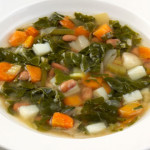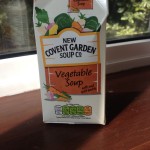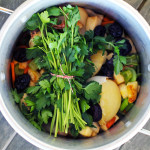Today I made the mistake of trying the New Covent Garden Soup Co‘s “new improved recipe” of “vegetable soup with red split lentils.” Yes, there are lots of soup varieties containing vegetables but here we’re talking about a generic combination of vegetables pureed into a soup. The description on the box reads thus:
“We have taken our all-time favourite vegetable soup and perfected our recipe to deliver the ultimate in vegetable soups. Our chefs have combiner carrots with turnips, red split lentils, parsnip and swede to create this chunky medley of vegetables to comfort the soul.”
The ingredients are listed as follows:
Water, carrots (15%), potatoes (6%), onions, parsnips (6%), cabbage (6%), swede (5.4%), celery (4%), turnip (4%), sweetcorn (3.5%), red split lentils (2%), milk, single cream, tomato paste, salted butter, salt, white pepper.
So if water is the main ingredient, why not list what proportion of the product is water? You could argue that makes it water soup with added veg, but such are the vagaries of labelling legislation. Being thankful for small mercies, at least there are no artificial colours and/or flavours, for which we must be grateful. Not too long ago these would have dominated the list, and doubtless in some cheaper products they still do.
You could devise many other combinations of veg, and maybe even question some of the proportions (why 5.4%, not 5.5 or 5.3?), but essentially this is a puréed root veg soup with minimal flavourings, no herts and no spices. Comfort food, to be sure, and reminiscent to some degree of the soups my mother made me as a child – as did mothers up and down the country, I’m sure.
However, on warming this soup, stirring well and serving my initial reaction was that it tasted of precisely nothing. I accept that some people may prefer under-flavoured soups, even if I am not one of them, but there is no doubt that the predominant flavour was that of water. If there was a flavour it was subtle, certainly nobody’s idea of “the ultimate in vegetable soups…to comfort the soul.” Don’t think I ever ate the previous version but I would not be at all surprised if one of the results of the change was that the soup is cheaper to make and therefore more profitable.
Clearly NCG Soup Co aim to be thought of at the high end of the market, while still manufacturing mass-market products, but in my estimation they could easily do better by returning to basics and focusing on flavours, so here is my view for the benefit of this and other manufacturers:
1. Stock
The first requirement of any soup is a top quality stock to act as a base, and this is no exception: water with a few veg added really can’t cut the mustard. Neither can commercial stock cubes, which have a tendency to taste artificial and to lack the depth of flavours of the real thing. Here is one recipe for an excellent veg stock, though there are many more, and here are a few tips to get the best from your stock:
i. chop fine
When I make meat based stock I tend to just roughly hack the veg and not bother to peel even the onions. When you’re looking to maximise the flavour from your vegetables, however, a finer dice is better as it increases the amount of surface area in contact with the water – so it’s easier for the flavours to be infused into the broth. You don’t need to go too crazy – it’s up to you how much time you’re prepared to spend cutting.ii. lightly brown your aromatics
Sweating your aromatic veg – the onion, celery and carrot helps them develop sweeter flavours with more complexity to add to your stock rather than just chucking them in raw.iii. be generous with the mushrooms
Mushrooms contain intrinsically high levels of glutamic acid which makes them little powerhouses of flavour enhancing goodness – we’re talking natural MSG that imparts those lovely savoury, umami-type flavours.iv. go for tomato
Tomatoes are another great source of savoury goodness. The colour they bring can be quite attractive, unless you want a neutral stock.v. start with cold water
Different flavour components have different levels of solubility in water at different temperatures. By starting cold and slowly increasing the heat, you can be sure that all the flavours have had a chance to be extracted at their preferred temperature.vi. let it simmer
To further extract all the flavour goodness, letting the vegetables gently simmer is optimum. Too high a heat and you can boil off some of the more delicate flavours, too low and you won’t coax all the flavour out of your veg.vii. taste as you go
I find it helpful to take a little sample at regular intervals and taste the stock. It’s then fun to keep samples from different times so you can taste them all together at the end and see how the flavour of your stock has developed over time. It also helps you decide when to stop cooking: when the flavour isn’t tasting any stronger between samples.
Truth is that you can add all manner of veg leftovers and peelings to add flavour. One of my favourites is the stalk from broccoli, which would otherwise be discarded. The herbs are essential, such as parsley stalks, thyme and bay leaves. If you’re sieving then niceties like bouquet garni are not required. I also like to crack peppercorns lightly and use sea salt crystals in preference to table salt to impart a deeper flavour.
2. Preparing the veg
In truth, you can use any veg – there is nothing magical about the selection chosen in this commercial soup. But as with veg going into the stock, the veg you cook in the finished stock benefits from being lightly roasted. It’s well known that red peppers are roasted to allow the skins to be peeled easily, but the secondary benefit is that the flavours intensify and concentrate. The same is true of squash (a fine addition to any veg soup) onions, root veg such as carrots and parsnips, and also mushrooms – though they benefit from a light coating of oil first.
3. Texture
Fine dicing is not essential but does make for an easier purée when complete – if that is what you want. Personally I always preferred a soup that was half-and-half; that is, the texture thickened and enhanced by puréeing veg, but some cubes of root veg left intact to give more bite. See also pulses (below.)
If you are going to puree, you can use a blender, or the good old-fashioned technique of pushing the softened mixture through a wire mesh sieve. It’s not difficult and does offer a slightly different texture. Always remember to reheat and stir well into the stock though.
4. Lentils and pulses
As a strong advocate of pulses, I would encourage their use in a soup, both as a thickening agent and to provide a soothing bulk and comforting taste. Red split lentils are attractive commercially because they require no prior soaking and break down within 20 minutes cooking into a mush, but other pulses offer a more attractive texture and flavour. Think of pearl barley used in a traditional Scotch Broth and it’s not difficult to see how some imagination can develop a range of combinations for a subtly different dish.
5. Flavourings and additions
Salt and pepper are essential, and a touch of milk and/or cream and/or cheese before serving is a nice touch, but whatever other herbs and spices you may like to add are a process of experimentation and personal taste. Remember that the essence of herbs included in your stock will deliver some potency, but those included in the soup will be a more direct hit on the palate, much as slow-cooked Indian dishes are often given a lively kick by the late addition of garam masala. Don’t overpower the soup with these ingredients unless you’re aiming for something like carrot and coriander, but find a blend that merges well and delivers a concentrated orchestra of tuneful flavours rather than a discordant ensemble.
6. Cooking
Where meaty soups benefit from a very long, slow cooking, veg soups tend to be at a consistency that permits serving well within the hour. As with all good stews, soups and casseroles, they still benefit from long, slow cooking, and also being prepared and cooked one day and leaving to mature and deepen overnight.
If you want my humble opinion, it’s better to spend a few minutes preparing and making your own is always better than the commercial equivalent.







